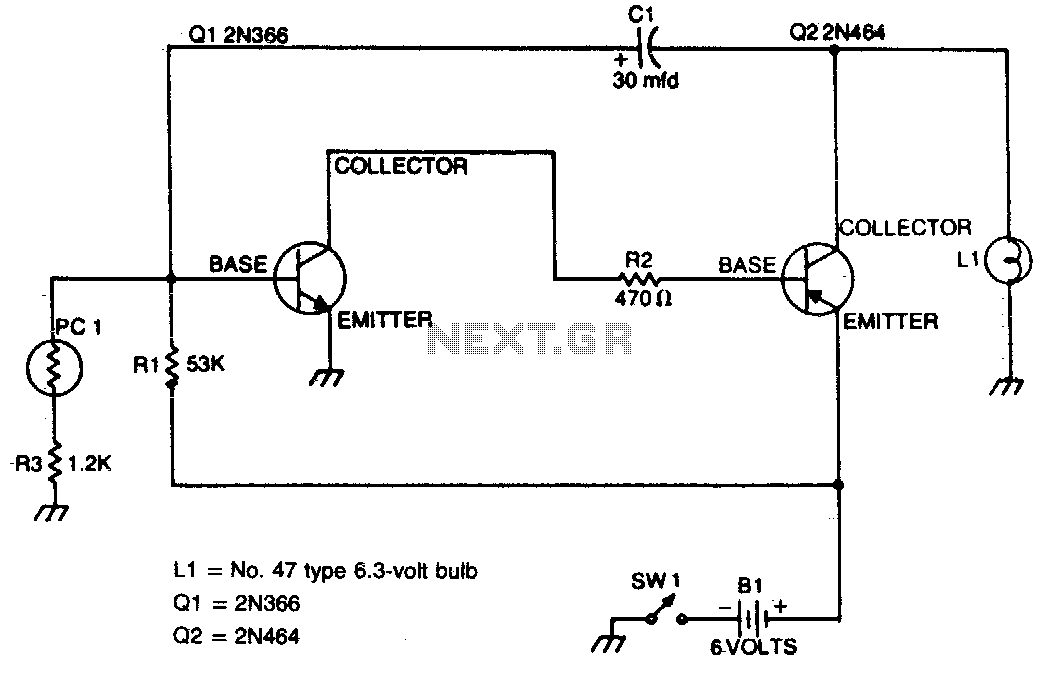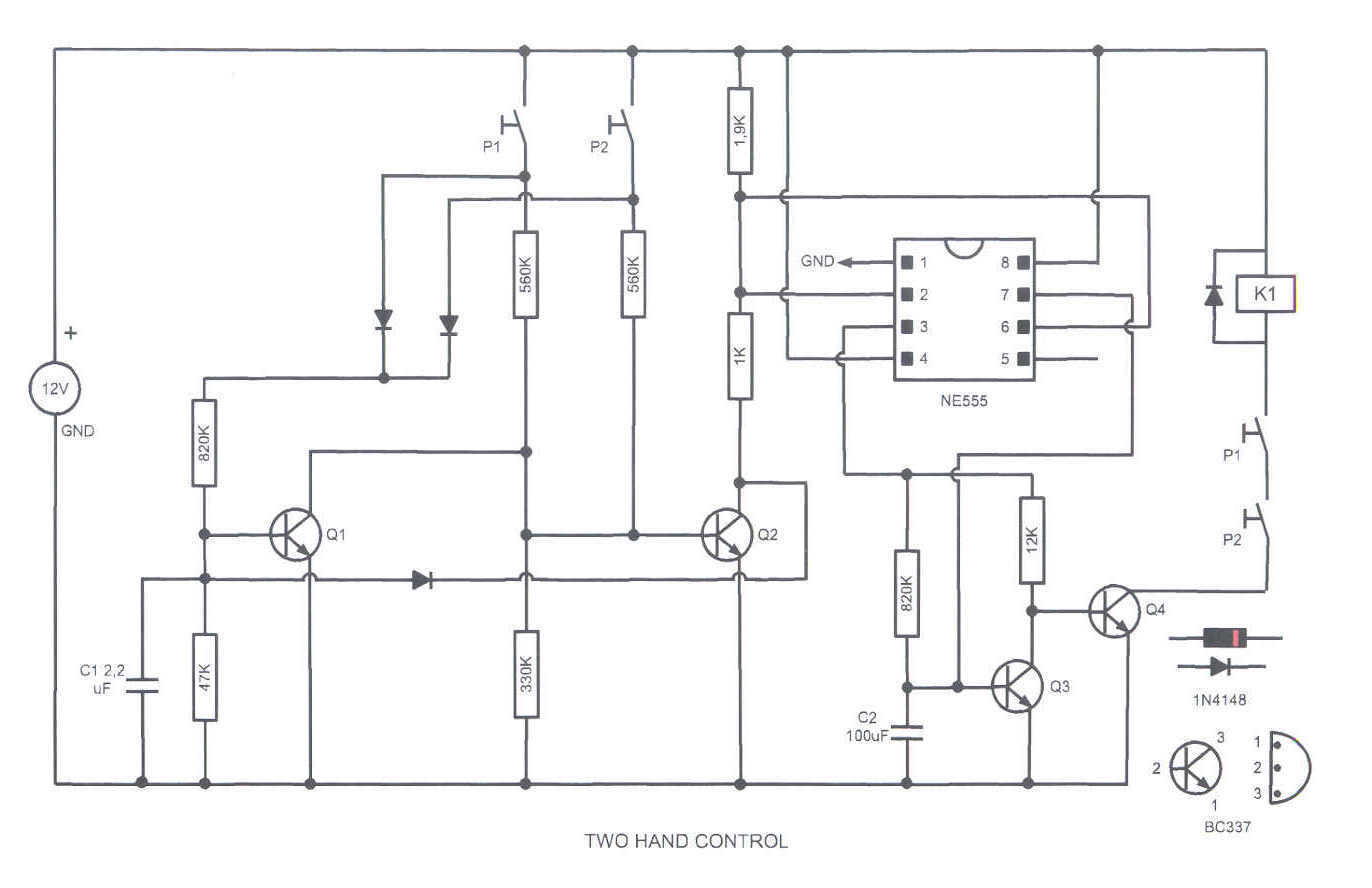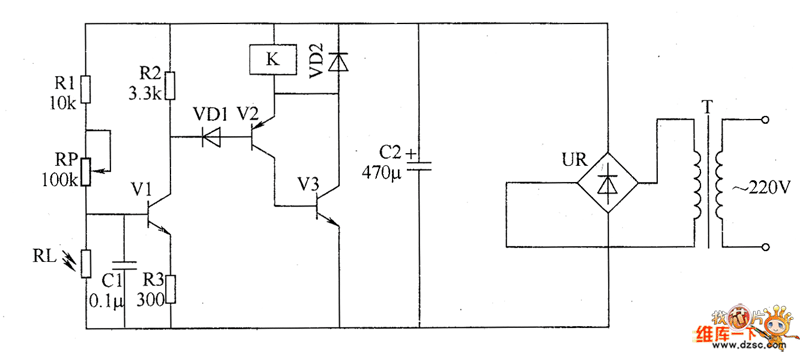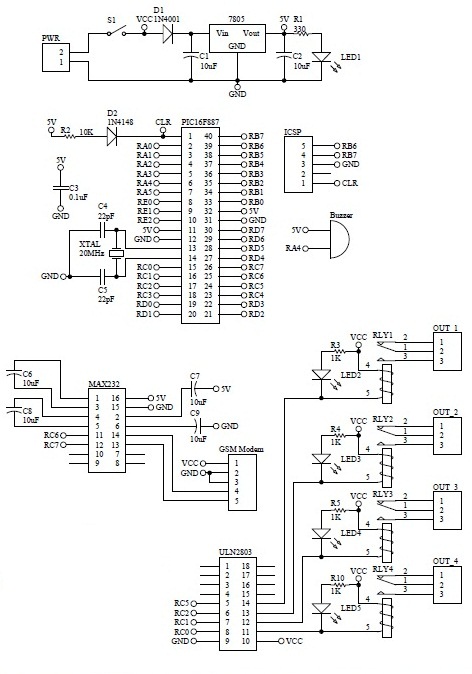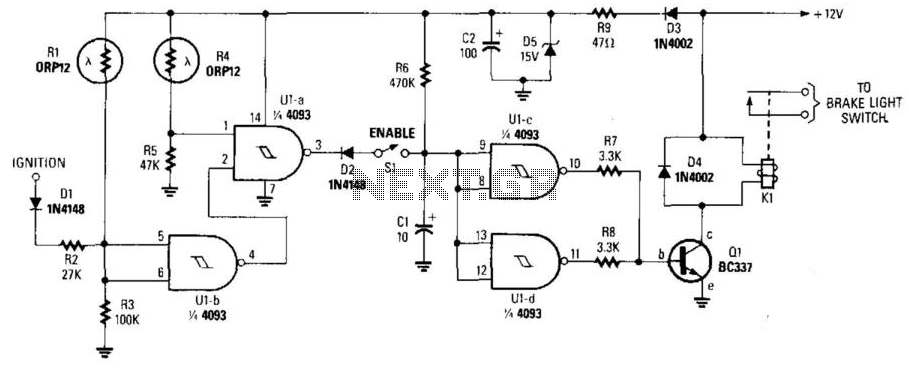
Safety flare
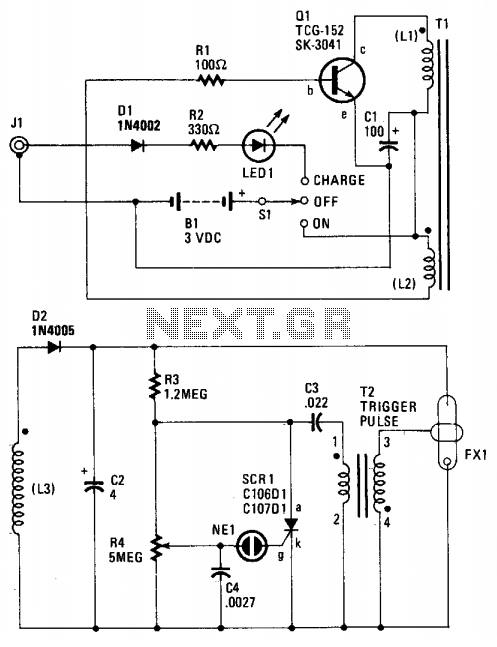
When the switch SI is activated, power is supplied to an oscillator that consists of Q1, R1, C1, L1, and L2. Coil L1 serves as the primary winding of transformer T1, while L2 functions as the feedback winding. As Q1 turns on, its collector current saturates the ferrite core of T1, which subsequently interrupts the base drive to Q1 via L2. This causes transistor Q1 to turn off. As the magnetic field around L1 and L2 diminishes, Q1 will eventually turn on again, repeating the cycle continuously. Transformer T1 is a step-up, ferrite-core, potted-type device, with the output from its secondary winding (L3) being rectified by diode D2 and filtered by capacitor C2. This capacitor charges to approximately 250 to 300 volts, which is then applied to a resistor divider made up of R3 and R4, in conjunction with the flash tube FX1. Capacitors C3 and C4 will charge to around 200 and 100 volts, respectively, through R3 and R4. The flash rate can be adjusted using R4. Once the voltage across C4 reaches about 100 volts, neon lamp NE1 activates, discharging C4 into the gate circuit of silicon control rectifier SCR1. The SCR1 turns on, discharging C3 into the primary winding of trigger-pulse transformer T2. Transformer T2 is another step-up, pulse-type unit that produces an output of around 4 kW across its secondary winding. The xenon gas within FX1 becomes ionized, resulting in a bright flash being emitted. Finally, capacitor C3 quickly discharges through L4, and the cycle repeats continuously.
The described circuit functions as a high-voltage flash generator, utilizing a feedback oscillator mechanism to drive the operation of a transformer and subsequently trigger a flash tube. The oscillator is initiated by the switch SI, which energizes the components Q1, R1, C1, and the inductors L1 and L2. The operation of Q1 is critical, as it controls the saturation of the transformer core, thus regulating the energy transfer to the output circuit.
The transformer T1, designed with a ferrite core, enhances efficiency in energy conversion, allowing for a significant voltage increase at the secondary winding (L3). The rectification process carried out by diode D2 ensures that the output is converted to a usable DC voltage, which is then smoothed by capacitor C2. The voltage levels achieved (250 to 300 volts) are essential for the subsequent operation of the flash tube FX1, which requires high voltage to ionize the xenon gas and produce a luminous flash.
The charging of capacitors C3 and C4 through resistors R3 and R4 is a critical aspect of the timing and control of the flash rate. The adjustable resistor R4 allows for fine-tuning of the flash frequency, providing versatility in applications that require different flash rates. The activation of the neon lamp NE1 serves as a trigger mechanism for the silicon control rectifier (SCR1), which plays a pivotal role in discharging C3 into transformer T2, thereby generating a high-voltage pulse.
The output from transformer T2, rated at approximately 4 kW, is substantial enough to ensure that the flash tube FX1 emits a bright and intense flash upon the ionization of the gas. The rapid discharge of capacitor C3 through inductor L4 signifies the end of one cycle and the readiness for the next, demonstrating the circuit's ability to operate continuously without interruption. Overall, this design exemplifies a sophisticated approach to generating high-voltage flashes for various applications, utilizing feedback control and efficient energy transfer mechanisms.When SI is on, power is applied to an oscillator composed of Ql, Rl, Cl, LI, and L2. Coil Ll is the primary winding of Tl, and L2 is the feedback winding. When Ql turns on, its collector current saturates Tl's ferrite core. That, in turn, removes the base drive to Ql through L2. Transistor Ql then turns off. As the field around Ll and L2 decays, Ql will eventually turn on again, and the cycle repeats over, and over. Transformer Tl is a step-up, ferrite-core, potted-type unit whose secondary-winding (L3) output is rectified by D2 and filtered by C2, That capacitor charges up to around 250 to 300 volts, which is applied to the resistor divider composed of R3 and R4, along with the flash tube FX1.
Capacitors C3 and C4 will charge up to around 200 and 100 volts, through R3 and R4, respectively. Flash rate is adjustable via R4. When the charge on C4 gets to around 100 volts, neon lamp NE1 fires discharging C4 into the gate circuit of silicon control rectifier SCR1. The SCR1 turns on discharging C3 into the primary winding of trigger-pulse transformer T2. Transformer T2 is another step-up, pulse-type unit providing an output of around 4 kW across transformer T2's secondary winding.
The xenon gas inside FX1 is ionized and a bright flash is emitted. Finally, C3 quickly discharges through L4, and the cycle repeats over, and over. 🔗 External reference
The described circuit functions as a high-voltage flash generator, utilizing a feedback oscillator mechanism to drive the operation of a transformer and subsequently trigger a flash tube. The oscillator is initiated by the switch SI, which energizes the components Q1, R1, C1, and the inductors L1 and L2. The operation of Q1 is critical, as it controls the saturation of the transformer core, thus regulating the energy transfer to the output circuit.
The transformer T1, designed with a ferrite core, enhances efficiency in energy conversion, allowing for a significant voltage increase at the secondary winding (L3). The rectification process carried out by diode D2 ensures that the output is converted to a usable DC voltage, which is then smoothed by capacitor C2. The voltage levels achieved (250 to 300 volts) are essential for the subsequent operation of the flash tube FX1, which requires high voltage to ionize the xenon gas and produce a luminous flash.
The charging of capacitors C3 and C4 through resistors R3 and R4 is a critical aspect of the timing and control of the flash rate. The adjustable resistor R4 allows for fine-tuning of the flash frequency, providing versatility in applications that require different flash rates. The activation of the neon lamp NE1 serves as a trigger mechanism for the silicon control rectifier (SCR1), which plays a pivotal role in discharging C3 into transformer T2, thereby generating a high-voltage pulse.
The output from transformer T2, rated at approximately 4 kW, is substantial enough to ensure that the flash tube FX1 emits a bright and intense flash upon the ionization of the gas. The rapid discharge of capacitor C3 through inductor L4 signifies the end of one cycle and the readiness for the next, demonstrating the circuit's ability to operate continuously without interruption. Overall, this design exemplifies a sophisticated approach to generating high-voltage flashes for various applications, utilizing feedback control and efficient energy transfer mechanisms.When SI is on, power is applied to an oscillator composed of Ql, Rl, Cl, LI, and L2. Coil Ll is the primary winding of Tl, and L2 is the feedback winding. When Ql turns on, its collector current saturates Tl's ferrite core. That, in turn, removes the base drive to Ql through L2. Transistor Ql then turns off. As the field around Ll and L2 decays, Ql will eventually turn on again, and the cycle repeats over, and over. Transformer Tl is a step-up, ferrite-core, potted-type unit whose secondary-winding (L3) output is rectified by D2 and filtered by C2, That capacitor charges up to around 250 to 300 volts, which is applied to the resistor divider composed of R3 and R4, along with the flash tube FX1.
Capacitors C3 and C4 will charge up to around 200 and 100 volts, through R3 and R4, respectively. Flash rate is adjustable via R4. When the charge on C4 gets to around 100 volts, neon lamp NE1 fires discharging C4 into the gate circuit of silicon control rectifier SCR1. The SCR1 turns on discharging C3 into the primary winding of trigger-pulse transformer T2. Transformer T2 is another step-up, pulse-type unit providing an output of around 4 kW across transformer T2's secondary winding.
The xenon gas inside FX1 is ionized and a bright flash is emitted. Finally, C3 quickly discharges through L4, and the cycle repeats over, and over. 🔗 External reference
